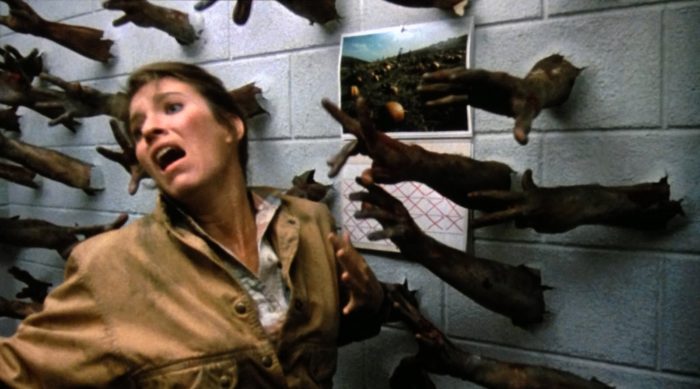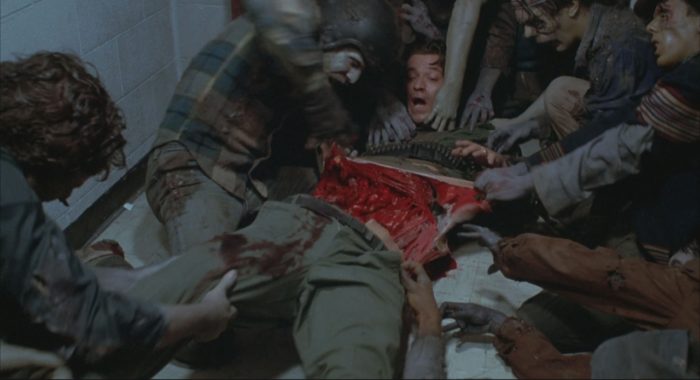
I saw the first Night of the Living Dead in the Nineties, when I was just a kid, too young to understand any of the movie’s themes. I watched it with my family and mostly remember being excited about the second tape that came with the movie, the parody Night of the Living Bread. I didn’t see its sequel (and the remake of that) until I was in college. I watched a downloaded copy of Dawn of the Dead in my dorm room by myself and absolutely was all about its criticisms of consumer culture and message of hope beyond all reason. Now, all these years later, thanks to the advent of (arguably too many) streaming services, I have finally completed watching the three Living Dead movies that matter.
I’ll say up front that Day of the Dead didn’t really live up to the versions of the first two movies that exist in my memory. I’d have to actually watch all three in a smaller period of time to make a better comparison. What’s also changed since I last checked in with the Living Dead is the state of zombies in pop culture. We’ve been living in a post-“maybe Rick and the others are the REAL Walking Dead” world for a long time now. It felt like the zombie trend came and went and came again and went once more, meaning that it’s pretty damn hard to come up with a new spin on this concept right now. There have been other zombie boom-and-bust cycles before, and I don’t know enough about the genre to really establish a context for 1985, so here are simply my thoughts on what Day of the Dead was to me, now.
For one, I love the progression of these three movies. Night was set at the very beginning of the phenomenon of corpses reanimating, Dawn picked up soon after and showed that this was a global catastrophe, and finally Day is set after society has almost entirely fallen. As Dr. Frankenstein (Richard Liberty) points out, the balance has finally shifted and there are certainly more zombies than living people on the planet. Much of Day is set in wide open spaces – desolate city streets, massive conference rooms – making the absence of more people a constant feeling throughout.
The few people we do have are a team of soldiers and scientists still trying to understand the living dead so that they might find a way to save the world. Caught in the middle is Dr. Bowman (Lori Cardille), a scientist whose resilience makes her stand out, even among her military comrades. She tries to keep the peace between Dr. Frankenstein, a man who is off the deep end with his work, and Captain Rhodes (Joseph Pilato), the latest in the soldiers’ line of succession and a man who has little patience for their desperate situation. Along for the ride are two civilians, John (Terry Alexander), a helicopter pilot, and Bill (Jarlath Conroy), a radio operator, who keep their distance from the others while they all lay low in an underground facility.
As is always the case, humans are their own undoing in Day of the Dead. Much of the middle of the film is the scientists and soldiers bickering, as the movie starts with tensions already quite high and escalates them quickly. Writer and director George A. Romero doesn’t shy away from grim societal realities, bringing attention to how uncomfortable Bowman is made as the only woman in the group, and showing how the two survivors who are also men of color have to deal with overt racism from their supposed allies. The America of the Eighties, just like the our world today, probably isn’t strong enough to survive this kind of disaster.
Meanwhile, Dr. Frankenstein has deduced how living dead biology works, and began a plan to socialize those shambling corpses. His masterpiece is Bub (Sherman Howard), a zombie the group captured that he has made somewhat docile. Bub displays some intelligence, like being able to recognize the doctor as his friend, and also shows some connection to his living self by saluting Rhodes when he sees him in uniform. The possibilities this side plot introduces are exciting to think about, and it does add a sort of I am Legend-style perspective to the movie, but mostly Bub is there to provide an amusing comeuppance during the inevitable blood bath at the end.
It’s not really my thing, but even I can tell that Day has the best gore effects of the Living Dead series. Tom Savini’s blood looked a little less bright and colorful, a little more real this time to go along with all the brutal deaths we see. No one just disappears into a mass of zombies this time around, now we get to see people torn to shreds before they go. And the stuff in Dr. Frankenstein’s lab is truly outlandish and disturbing. The body parts and bizarre experiments are the stuff of nightmares, just top notch horror makeup and prop-making there. I’m sure that’s why this movie has endured as it has, but hey, the rest is pretty great too.


